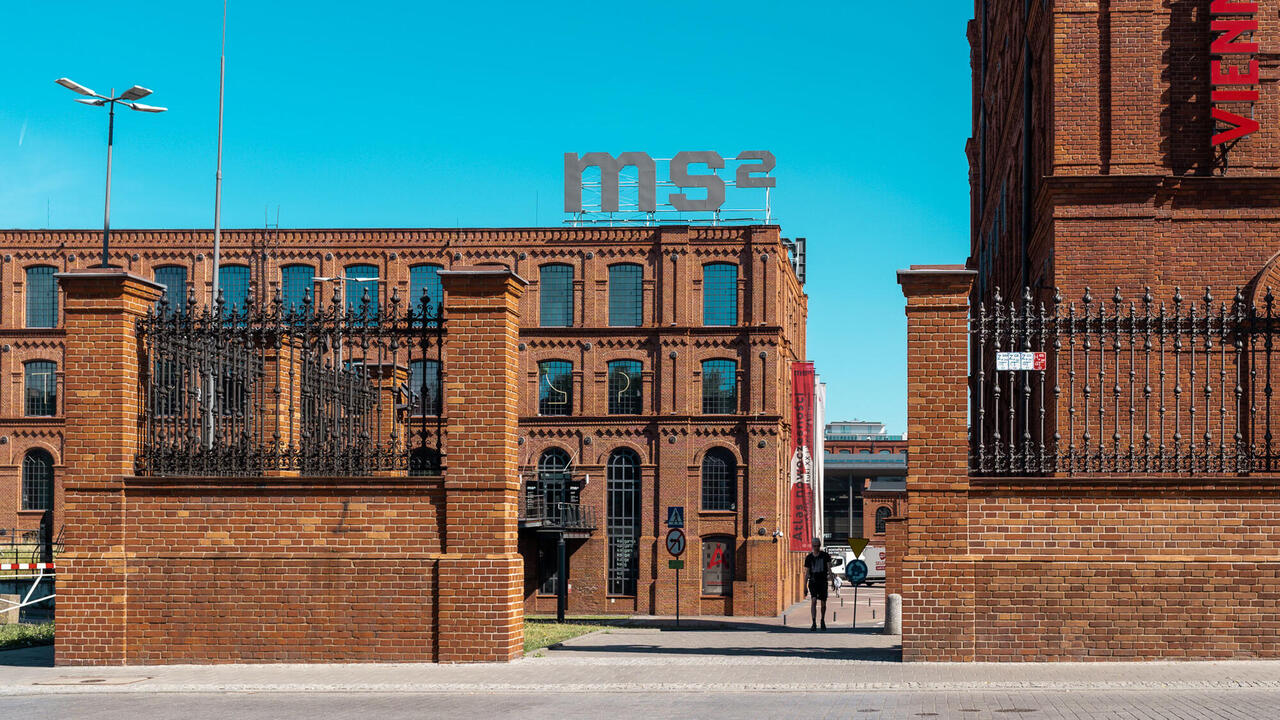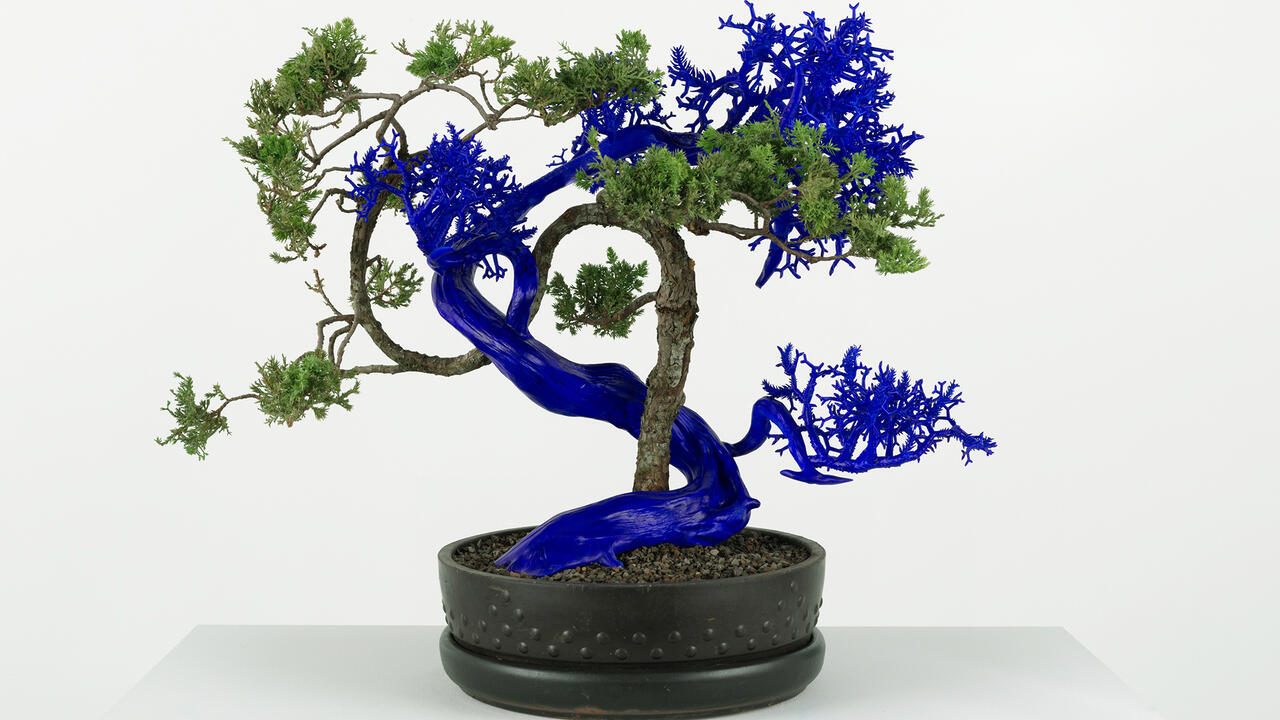Laura Owens
Whitney Museum of American Art, New York, USA
Whitney Museum of American Art, New York, USA

In 1993, when Laura Owens was a first-year student at the California Institute for the Arts, Charles Gaines completed a ‘mentor’s report’ of the painter’s progress in her MFA. He assessed Owens’s work in three concise sentences, imploring her to make her voice ‘clearer’ so that the programme might gain a better sense of ‘what the objects meant to you.’ ‘I think you are close’, he concludes, ‘but there is an edge that needs to be exposed yet.’ Nearly a quarter of a century later, we may now think of Owens as a painter of the exposed, deckled, broken and blunted edge, on occasion of her untitled mid-career survey at the Whitney Museum of American Art in New York. There, 60 paintings spanning three decades provide a funny, even exuberant riposte to the drab tidings of the current moment, with humour and roseate flare. Owens ‘has always had a particular relationship to the edges’, frieze contributing editor Kirsty Bell writes in ‘On Laura Owens’ Idea of Edges’, an essay included in the exhibition catalogue. ‘She seems congenitally disposed to overstep them.’

At the Whitney, Chief Curator Scott Rothkopf has arrayed a substantial view of Owens’s sidewinding career, including extended quotations of the artist’s exhibitions dating back to the 1990s, that runs along those edges the artist has sought to define and erase through a doodling, comic sensibility. Emerging in California at a moment when painting was viewed with suspicion at CalArts, Owens reinvigorated the medium ‘by appearing not to take it too seriously’, as the museum declares in an introductory wall text. From this, the Whitney tracks Owens’s development from early efforts, such as Untitled (1995) – a wonky painting of a salon-style room of pictures, seen from the point of view of ‘an insect or small child’ – to more recent work. From Untitled’s grasshopper vantage, the distant works-within-the-work are mostly vague and abstract, made by friends and family who dropped by Owens’s studio. The painting was exhibited in the artist’s first solo show that same year, and its roundabout inclusion of friends established early-on the artist’s preoccupation with a dreamy, recursive seriality that came to define her work as well as the importance she has placed on collaboration and friendship.
Part of the success of Owens’s playful style arises from the seriousness with which she approaches the dense network of internal references – from Modernism to IKEA-like installations – that link individual works and exhibitions. Paintings indirectly reflect or nod to other paintings, hint at separate bodies of work, peers, forebearers and even lovers. Several early installation works, for example, were made in collaboration with the artist Jorge Pardo, whom she dated in the ‘90s. In Untitled (1997), a darkly rendered still-life, one catches a glimpse of another painting (also untitled, and from that same year) in a small scuffed mirror placed upon a wooden table beside a vase of flowers. Later paintings recall one another through recurring motifs, like bespectacled monkeys, or clocks, as in ‘Untitled’ (2011–12), a series of 61 x 61 cm paintings – first exhibited at The Finley, a small gallery in the stairwell of an apartment building in Los Angeles – that feature a number of rotating clock-hands that do not tell actual time. Or rather, they tell only of Owens’s time: a sort of Mad Hatter’s hour of pinks and purples and blues, funny faces, flowers and abstraction, all of it stoned on florid enthusiasm.

The clock paintings run along the tops of walls at the Whitney, occasionally diverging from the well-lit gallery spaces, where several freestanding enclosures create multiple narrow passages between rooms, into shadow, down corridors, inviting us to chase them into the half-dark. This line of paintings provides one path around the show, and one that foregoes chronological linearity and, moreover, alters the usual course set for the museum-goer’s eye by demanding that we look up before we look ahead. Several paintings – particularly later works, when Owens turned to the figure in 2000 – have been hung high or salon-style, providing a see-saw arrangement of cute kids and contortionist horses and pretty medieval scenes that repeatedly divert the exhibition’s expected sightline.
In a series of 2.7 x 2.1 metre, digitally-manipulated paintings first exhibited at Sadie Coles in ‘Pavement Karaoke/Alphabet’, Owens skirts the edge between flatness and dimensionality by upending both: looping arches, each ‘made entirely on the computer and then physicalized’ (per Calvin Marcus, a studio-assistant quoted in the catalogue), layer in great, excited whirligigs across screen-printed newspaper want ads. Brushstrokes appear to have been partially created, and then erased by, Photoshop. ‘She cites modernism in pinks and blues’, Gaines remarked in another progress report at Cal Arts, and the works of ‘Pavement Karaoke’ might be read as slyly condensed synopses of modernist painting that combine the early collagist experiments of Pablo Picasso and Georges Braque of the 1910s – where the difference between actual mixed media and the illusion of such is blurred against an occasional newsprint backdrop – with Henri Matisse’s vibrant cut-outs of the 1940s.

Owens’s big paintings shrink the viewer down, returning us to that grasshopper’s vantage point established at the outset of her career in Untitled (1995), before her recent canvases of cats and cartoon figures cribbed from 1970s children’s storybooks. In more recent work, that view might be better understood as a child’s, given the importance of motherhood to the artist’s practice, evinced by Owens’s many paintings of her children and the inclusion of family photographs in the exhibition catalogue (including one of her daughter, Nova, grinning before Untitled, 2008, which depicts a nude mother and child). One feels kid-sized in awe of the swirling, curious world these paintings capture, as if they glimpse askance adulthood: a tumbling fleet of cats; a crescent moon smiling at a clutch of stars, like wallpaper for a baby’s room. In another large work, a cartoon boy and his dog cling to a rope – and beside them, the caption reads: ‘When you come to the end of your rope, make a knot, and hang on’. Much of Owens’s language nods to children’s books. 'Untitled' (2015) – a series of free-standing paintings of a handwriting practice book – spell out an incomplete story: ‘There was a cat and an alien,’ it reads, ‘They went to antarctica. Then they teleported to the center of the earth. There they got 11,000000 bombs and blew them up and turned’.
We might imagine, 22 years since Owens represented a child’s perspective of a gallery of pictures in Untitled (1995), the child is the artist herself, standing in awe of painting’s seemingly endless possibilities: its smeared language of history, its frayed, even uncool reputation, its openness to anything. Its open mouth, its full-lips, its kissy flirtations, its gobbling hunger: painting that swallows, swallows one whole. And brought down to the floor-level in Untitled, one imagines Owens went to feed the beast only to find herself its meal.
Main image: Laura Owens, installation view, Whitney Museum of American Art, New York, 2017-18. Courtesy: Whitney Museum of American Art, New York; photograph: Ron Amstutz

























